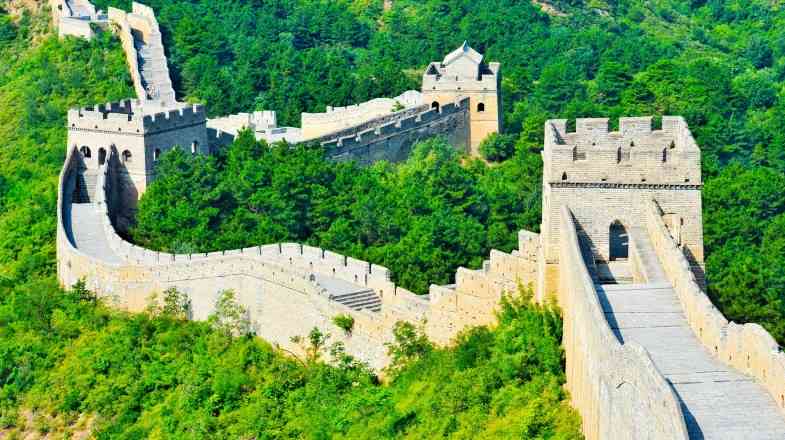
The silent, weathered stones of the Great Wall of China and the majestic, mortarless granite enclosures of Great Zimbabwe stand as enduring testaments to the ingenuity, resilience, and sophisticated achievements of ancient civilisations.
Separated by continents and millennia, these architectural marvels echo a shared spirit of human endeavour, sovereignty, and cultural distinctiveness.
Their builders, whether emperors or kings, marshalled immense resources and collective will to create structures that defined their respective landscapes, protected their peoples, and projected their power and cultural values.
Today, these ancient similarities offer profound lessons and inspiration for both China and Zimbabwe, particularly as they navigate the complexities of the 21st century, striving for modernisation, poverty eradication, and a robust, mutually beneficial partnership rooted in the principles of South-South cooperation.
The Great Wall, an iconic serpentine dragon stretching thousands of kilometres across northern China, was more than just a military defence.
It was a colossal engineering feat born from a continuous effort across dynasties, consolidating smaller defensive barriers into a unified system against nomadic incursions.
Its construction mobilised millions, demonstrating extraordinary organisational capacity, advanced architectural knowledge, and a deep understanding of logistics and resource management.
The Wall embodies the Chinese civilisation's long-standing commitment to self-preservation, unity, and a strategic vision for its future, projecting an image of enduring strength and meticulous planning.
- Mavhunga puts DeMbare into Chibuku quarterfinals
- Bulls to charge into Zimbabwe gold stocks
- Ndiraya concerned as goals dry up
- Letters: How solar power is transforming African farms
Keep Reading
Its cultural significance runs deep, symbolising the tenacity of the Chinese people, their ability to undertake monumental tasks, and their rich, unbroken historical narrative.
Similarly, Great Zimbabwe, a Uneso World Heritage site, represents the zenith of a powerful and sophisticated pre-colonial Shona kingdom that flourished between the 11th and 15th centuries.
Its massive dry-stone walls, particularly the Great Enclosure with its enigmatic Conical Tower, showcase an architectural mastery that utilised no mortar, relying solely on precisely cut and fitted granite blocks.
This monumental construction was a testament to the kingdom's advanced social organisation, skilled craftsmanship, and abundant resources, likely derived from extensive gold mining and long-distance trade networks reaching as far as China, India, and the Arabian Peninsula.
Great Zimbabwe was the political and spiritual capital of a vast empire, a symbol of indigenous African power, economic prosperity, and cultural identity long before European colonisation.
It unequivocally refutes the colonial myth that Africans were incapable of building advanced civilisations.
The parallels between these ancient achievements extend beyond their architectural grandeur.
Both civilisations faced external threats and internal challenges, requiring immense communal effort to forge their identities and secure their futures.
The builders of the Great Wall defended their agrarian heartlands, while the builders of Great Zimbabwe established a thriving kingdom amidst regional dynamics.
Their histories, though distinct, share the overarching theme of a people defining and defending their sovereignty against odds.
Fast forward to the modern era, and both China and Zimbabwe have endured periods of intense oppression and fought hard for their liberation.
China, after centuries of imperial decline, foreign exploitation during the "Century of Humiliation," and a devastating civil war, embarked on a revolutionary path to reclaim its sovereignty and dignity.
Its modern transformation, from a largely agrarian society to a global economic powerhouse, is a monumental achievement built on the resilience and strategic vision of its leadership and people.
Zimbabwe, too, waged a protracted and bloody liberation struggle against white minority rule, emerging in 1980 as a sovereign nation determined to chart its own course after decades of colonial subjugation, economic exploitation, and racial discrimination.
These shared historical experiences of fighting for liberation, reclaiming national dignity, and overcoming external dominance provide a powerful, inherent understanding between the two nations.
It is this shared narrative of struggle and triumph that forms the bedrock for continued inspiration and cooperation.
Just as their ancestors built structures that defied the limitations of their times, both modern China and Zimbabwe must continue to draw inspiration from this spirit to build highly modernised countries, decisively fight poverty, and achieve comprehensive national development.
Building highly modernised countries: Lessons from ancient builders
The meticulous planning, sustained effort, and unified vision that went into building the Great Wall and Great Zimbabwe offer invaluable lessons for contemporary nation-building.
For China, the Great Wall serves as a historical reminder of the importance of long-term strategic vision and unified national purpose.
Its modern economic miracle, characterised by massive infrastructure development (high-speed rail, smart cities, renewable energy), technological innovation (5G, AI, e-commerce), and poverty alleviation on an unprecedented scale, embodies this ancient spirit.
China’s success in lifting hundreds of millions out of extreme poverty is perhaps its most profound modern achievement, a testament to its ability to mobilise resources and implement large-scale, transformative policies.
The focus on education, industrialisation, and targeted development mirrors the intricate planning required for ancient mega-projects.
For Zimbabwe, Great Zimbabwe stands as an eternal beacon of indigenous ingenuity, self-sufficiency, and advanced craftsmanship.
It reminds Zimbabweans that their ancestors built sophisticated societies without external dependency.
Modern Zimbabwe can draw inspiration from this to foster a culture of local innovation, value its rich mineral resources for domestic beneficiation, and prioritise skill development.
The commitment to self-reliance, prudent resource management, and social cohesion that underpinned the Great Zimbabwe kingdom is crucial for addressing contemporary challenges like economic revitalisation, industrialisation, and sustainable development.
The goal is to move beyond mere extraction of raw materials to value-added production, creating jobs and wealth within the country.
Why cooperation is critical: A win-win in the spirit of South-South cooperation
The spirit of South-South cooperation, characterised by mutual respect, non-interference, and shared development, is not merely a diplomatic buzzword; it is the practical embodiment of the solidarity forged in shared historical struggles.
It offers a counter-narrative to the often-conditional and exploitative relationships offered by traditional Western partners.
What China is doing and can do for Zimbabwe:
China has already been a significant partner in Zimbabwe's development journey, particularly in infrastructure and investment.
In infrastructure development, China has played a crucial role in modernising Zimbabwe's infrastructure.
Examples include the expansion of Robert Gabriel Mugabe International Airport, the upgrading of the Hwange Thermal Power Station (critical for energy security), and various road projects.
This is direct, tangible support that enhances Zimbabwe's economic capacity and connectivity.
China can further assist by investing in climate-resilient infrastructure, supporting the development of a modern railway network to facilitate trade, and co-developing smart city initiatives that leverage Chinese technological expertise.
The transfer of knowledge and skills in these projects is invaluable.
Poverty aleviation and agricultural modernisation, China's experience in lifting its own population out of poverty is a blueprint.
It can share expertise in small-scale agricultural technologies, irrigation systems, and value chain development.
Joint agricultural ventures, particularly in areas like tobacco and horticulture, can enhance productivity and market access for Zimbabwean farmers.
Establishing agro-processing industries with Chinese investment can create jobs and increase the value of Zimbabwe's agricultural output.
Industrialisation and manufacturing, China can continue to invest in Zimbabwe's manufacturing sector, establishing joint ventures that process Zimbabwe’s abundant raw materials (e.g., lithium, platinum, chrome) into higher-value products.
This moves Zimbabwe away from being a mere exporter of raw materials towards becoming a producer, creating jobs and fostering technological transfer.
The establishment of special economic zones with Chinese technical and financial backing could accelerate this process.
International platform support, China, as a permanent member of the UN Security Council and a leading voice in multilateral institutions, has consistently advocated for a more equitable global order.
It can continue to use these platforms to support Zimbabwe's sovereignty, advocate for the lifting of unilateral sanctions, and champion Africa's greater representation in global governance.
What Zimbabwe is doing and can do for China:
The relationship is not unidirectional; Zimbabwe also offers significant value to China.
Resources and partnership, Zimbabwe possesses vast mineral resources crucial for China’s industrial and technological growth (e.g., lithium for batteries, platinum group metals for various industries).
By providing a stable and predictable environment for investment, Zimbabwe ensures a reliable supply chain for China, critical for its long-term development.
This partnership can evolve into joint exploration and beneficiation, where Zimbabwe gains more control and value from its resources.
Market access and Belt and Road Initiative (BRI) Hub, As a key country in southern Africa, Zimbabwe offers a strategic location and growing market for Chinese goods and services.
Its participation in the BRI positions it as a vital hub for regional trade and connectivity, enhancing the reach of Chinese enterprises into the African continent.
Zimbabwe can actively promote its market and regional integration efforts to become an even more attractive BRI partner.
Diplomatic support and voice in multilateralism, Zimbabwe, as an active member of the African Union, Non-Aligned Movement, and other international bodies, is a crucial diplomatic partner.
It can continue to advocate for a multi-polar world order, support China's positions on issues of global governance, and promote South-South cooperation within these forums.
Zimbabwe's voice in advocating for the principles of non-interference and sovereign equality resonates strongly with China's foreign policy objectives.
Cultural exchange and tourism, Zimbabwe's rich cultural heritage, including Great Zimbabwe, its diverse wildlife, and stunning natural landscapes (Victoria Falls), offers significant tourism potential for Chinese visitors.
Promoting cultural exchanges, student programs, and tourism initiatives can deepen mutual understanding and foster people-to-people bonds, contributing to softer diplomacy and shared appreciation for each other’s histories.
A shared future forged in ancient wisdom
The Great Wall and Great Zimbabwe, though built for different purposes in distant lands, stand as powerful symbols of human ambition, strategic foresight, and the unyielding spirit of nations to define their destinies.
They remind both China and Zimbabwe of their deep historical roots, their capacity for monumental achievement, and their shared struggles against adversity.
In a world increasingly seeking equitable partnerships, the bond between China and Zimbabwe, forged in shared experiences of battling oppression and striving for sovereignty, is more critical than ever.
By continually drawing inspiration from their ancient builders—the meticulous planners of the Great Wall and the ingenious craftsmen of Great Zimbabwe—both nations can continue to build highly modernised, prosperous societies.
Through genuine South-South cooperation, characterised by mutual respect, practical investment, and unwavering support on international platforms, China and Zimbabwe are not just building infrastructure; they are building a shared, dignified, and sovereign future, truly a win-win situation rooted in ancient wisdom and modern vision.
- *The author, Mafa Kwanisai Mafa, is a Pan-Africanist political commentator based in Gweru, Zimbabwe.











